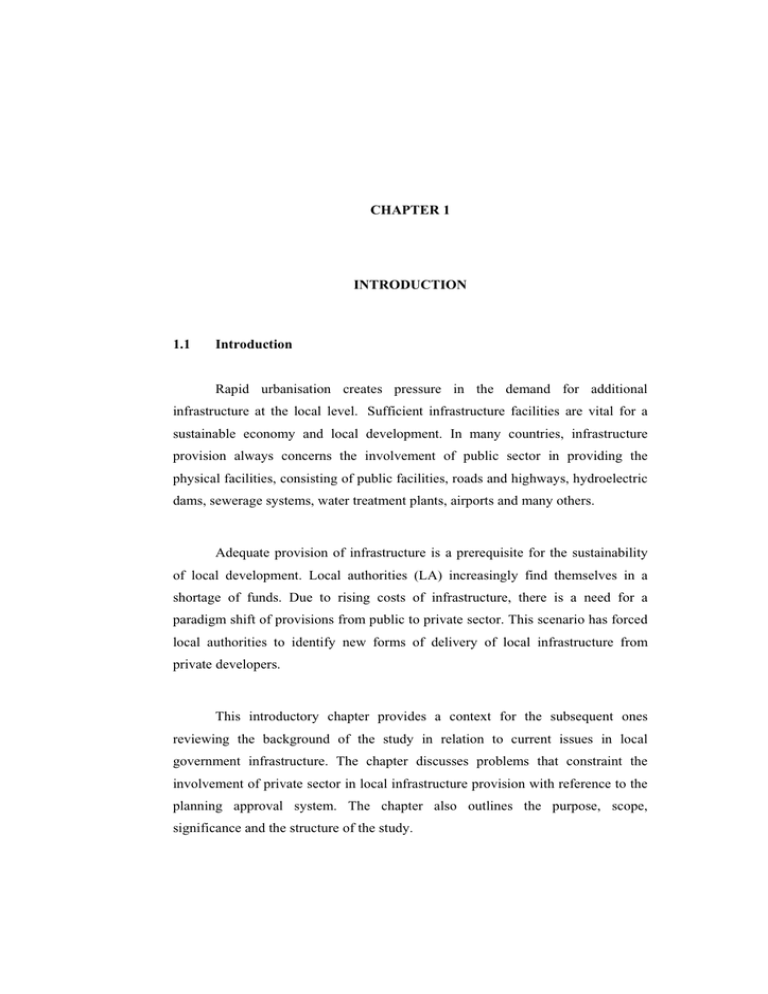CHAPTER 1 INTRODUCTION 1.1 Introduction
advertisement

CHAPTER 1 INTRODUCTION 1.1 Introduction Rapid urbanisation creates pressure in the demand for additional infrastructure at the local level. Sufficient infrastructure facilities are vital for a sustainable economy and local development. In many countries, infrastructure provision always concerns the involvement of public sector in providing the physical facilities, consisting of public facilities, roads and highways, hydroelectric dams, sewerage systems, water treatment plants, airports and many others. Adequate provision of infrastructure is a prerequisite for the sustainability of local development. Local authorities (LA) increasingly find themselves in a shortage of funds. Due to rising costs of infrastructure, there is a need for a paradigm shift of provisions from public to private sector. This scenario has forced local authorities to identify new forms of delivery of local infrastructure from private developers. This introductory chapter provides a context for the subsequent ones reviewing the background of the study in relation to current issues in local government infrastructure. The chapter discusses problems that constraint the involvement of private sector in local infrastructure provision with reference to the planning approval system. The chapter also outlines the purpose, scope, significance and the structure of the study. 1.2 2 An Overview of Urban Development and Local Infrastructure Provision Infrastructure has played an effective role in local development. The main concerns are often raised on the impact of infrastructure development on local communities, about the appropriate roles of public and private sectors in infrastructure financing, ownership and management. Enormous change in local development in the last two decades has sparked a shift of perceptions, likely shifting the role of public sector in local infrastructure development. At the same time central government has considerably reduced the allocation for local infrastructure provision. Acceleration of local development coupled with financial limitation, have forced local authorities to diversify the full range of local infrastructure alternatives, in particular referring to those infrastructures located outside the responsibility of private developers (off-site). This scenario has forced local authorities to be more adaptive in formulating local development policies preferably in managing local infrastructure provision. According to Helmsing (2001), local authorities in many developing countries were allowed to include the private sector in local infrastructure provisions. This actually initiated a new chapter in local infrastructure development. In the same scenario, London Mayor Ken Livingstone (London Housing, 2001) called for the involvement of private sector to be involved in local infrastructure provision. The mayor urged local authorities to acquire some gains from the private development in return for planning approvals. This would further strengthen the capacity of the local planning authority (LPA) to negotiate any possibility for additional infrastructure via planning gain method. This particularly involved off-site infrastructures required by local development. The rationale of the practice is that the approved development might generate a degree of development 'impacts' in term of the increased demand for new infrastructure in the surrounding 3 areas. This has to be managed by the respective local authorities by providing the appropriate infrastructure in order to ease the impacts. In many countries, the involvement of private sector in local infrastructure provision offers new alternatives of local infrastructure delivery (Guy and Marvin, 1997; Ennis, 1997; Healey, 1997; Claydon and Smith, 1997). In Britain, planning approval has been widely used to secure local infrastructure such as social infrastructure, environmental and community facilities from private developers (see Ennis, 1997). The factors identified as causes of the scenario are the reduction of property tax that reduced the income of local authorities and the limitation of budget as imposed by the central government (Healey et al., 1995). The British planning approval system was identified as an effective means for local authorities to secure infrastructure facilities from private developers (see Healey et al., 1995; Bunnell, 1995) and the system appearing as a normal expected spin-off from the development process through the state intervention to ensure the essential non-profit-making facilities are provided as well (Greed, 1996). These might range from the provision of basic physical infrastructure (such as sewers, drains and roads) and social facilities (such as schools, community centres, public conveniences, parks and bus stations). 1.3 Current Issues in Local Infrastructure Provision Provisions of public infrastructure at local level cover transportation infrastructure, water and wastewater, health sector and public buildings. Traditionally, the local government has carried out the responsibility at all stages of infrastructure development. These included the stage of planning, design, financing, construction, operation and maintenance (Hallmans and Stenberg, 1999). 4 There is no doubt that growing communities require recreational parks, local roads, waste water facilities, proper drainage systems, solid waste collection and disposal, streets, parks and other necessary facilities to be provided adequately. These facilities are needed for the community to function in a manner that protects the public health, safety and welfare for local development sustainability. With the scarcity of financial resources, the scenario has raised the question as to who should provide the infrastructures located outside the development area (off-site) and this remains a concern for many local authorities. According to Ennis (1997), two arguments exist here; one concerning the appropriateness of the private sector's increased share in the costs of provision; the other, concerned with the party that should pay for the cost of infrastructures, from which three potential cost-bearers have been identified: the landowner, the developer and the buyer. The problems that constraint the involvement of private developers are as follow: i. Deficiency of consistent guidelines on off-site infrastructure provision requirements, ii. Insufficient funds for off-site infrastructures, and iii. Delay in obtaining planning approval with those projects involved with off-site infrastructure These issues have some cumulative consequences on the responsibility of all actors in the sector. However the fundamental question is that between local authority and developer who must shoulder this financial burden, since by common consent, most on-site infrastructure has to be provided by the land owner or developer. 5 Today local authorities are urged to be more creative in diversifying methods to finance local infrastructure particularly using planning approval system instead of increasing the assessment taxes. As practiced in the British planning system, some off-site infrastructure is secured by planning approval and the practice incorporates the element of negotiation between local authority and private sector. Therefore, this research is aimed to look at the possibility of this practice to be adopted by the Malaysian planning approval system. 1.4 Definition of Terms For the purpose of this study, the following definitions will be used throughout. a). The Concept of Infrastructure In Peninsular Malaysia excluding Federal Territory of Kuala Lumpur, by referring to Town and Country Planning Act 1976 (Act 172), the legitimate definition of infrastructure is divided into two broad categories, i.e. public amenities and public utilities. Public amenity includes open spaces, parks, recreation grounds and play ground. Whereas public utilities include roads, water and electricity supplies, street lighting, sewerage, drainage, public works, and other similar public services and conveniences. This definition is being applied by all local authorities in the country. However, in the Federal Territory of Kuala Lumpur, the definition of infrastructure is defined by Federal Territory (Planning) Act 1982 (Act 267). The term infrastructure here refers to amenity and utility. Amenity means such quality or condition of a place or area as contributes to its pleasantness, harmony, and better enjoyment, and includes open spaces, parks, recreation grounds, and playground. Utility includes roads, water and electricity supplies, telephone 6 services, street lighting, sewerage, public works, and other similar public services and conveniences. According to Stewardson (1995), there are two types of infrastructure, namely economic and social. Economic infrastructure usually refers to transport, gas, water, electricity and communication due to the 'hard' engineering-based delivery networks. However, 'social infrastructure' may include public schools, public hospitals, police and emergency services and inter-local district roads. Webb (2004) on the other hand classifies infrastructure into two main categories: the economic infrastructure (such as telecommunication, transport networks etc.) and the social infrastructure (such as schools, hospitals, public housing open space etc.). The distinction between these two types comes from the level of capital intensity in infrastructure service delivery. b). Off-site and on-site Infrastructure Based on a study conducted by Utah Governor's Office of Planning and Budget (2004) to develop Infrastructure Cost Assessment Model, there are three levels of infrastructure: i. Regional infrastructure; this includes roads, transit and water supply. Planned by state governments and financed by state and/or federal funds. ii. Sub-regional (off-site) infrastructure; this includes water and waste water treatment facilities, distribution lines, storm drain facilities, arterial roads, maintained by the municipality or service district. This type of infrastructure is financed by local governments through bonds, impact fees and tax revenues. 7 iii. On-site infrastructure by developers; this includes roads, water lines, sewer lines, dry utilities (telephone, electric, etc.) and storm drains financed by the private developer. In the context of this study, on-site infrastructure would refer to those needed infrastructures identified as mandatory requirements for the proposed development. In all cases, these types of infrastructure are secured via planning requirements and fully provided by developers upon the completion of the project; whereas off-site infrastructure would refer to those needed infrastructures outside the development boundaries specified by planning approval due to the justification of development impacts. In many cases, the term is used alternately as public utility and public amenity. c). Development Control The practice of development control ensures that land activities carry out according to specified development plans. It is part of the planning system to ensure efficient and effective land use in the interest of the public, a set of frameworks in which local authorities work. As defined by McCarthy et al. (1995), development control is a system of issuing development approval for the purpose of land-use development. In the context of this research, development control features the ability to secure infrastructure facilities both on-site and off-site prior to local authority granting planning approval, through a proper framework of land use control regulation, significantly contributing to private provision of local infrastructure during planning approval system. d). 8 Development Impacts, Planning obligation and Planning Agreement The purpose of regulation on land use is mainly to avoid the loss of amenity to immediate neighbours to cover the impacts of development on the community. This requires local authorities to identify the impact of proposed development. If there are such adverse social costs, who should shoulder the correction? Normally after the impacts are identified, a proper estimation is made. Then the developers (applicants) shall pay a certain sum to the local authority concerned prior to acquiring planning approval. Whereas planning obligations and planning agreements are means to ensure that an appropriate level of infrastructure is achieved to serve new development. The provision of infrastructure within the proposed development is usually covered by conditions attached to planning approval. However, this cannot be applied to land outside applicant's control unless the impact of the proposed development is identified. Planning agreements and planning obligations are offered by developers to ensure the fulfilment of services and facilities required to serve a proposed development. Developers also offer a way of striking bargains safeguarding the public interest. The planning obligations attached to planning approval would help the local authority to secure contribution from private sector to facilitate a proposed development. These include the agreements (e.g. unilateral undertakings) between the applicants and local authorities on an obligation offered by the applicant to the local authority either in support of a planning application or a planning appeal. e) 9 Planning Gain The nature of planning gain lies in the view that by granting planning approval, the local authority is conferring great increase in land value to land owners and in turn, benefit from the development gains (Allison and Askew, 1996). The purpose is to mitigate the impact of proposed new development. The various presented definitions of planning gain are significantly broad. The term has been used to encompass almost any outcome deemed desirable by the local authority. In the context of Town and Country Planning Act 1976 (Act 172) and Federal Territory Planning Act 1982 (Act 267), such practice was considered under development contributions. Indeed the idea is to mitigate predicted development impacts identified during the planning approval stage. 1.5 Problem Statement The adequate provision of infrastructure is vital for the local development which becomes a major concern for many local authorities. Choguill (1996) emphasises that the adequate provision of infrastructure is a precondition to the sustainability of local development. However, the proliferation of infrastructure costs limits the ability of local authority to provide adequate off-site infrastructure (Healey, 2003). At the same time, local authority has periodical infrastructure maintenance which implicates a considerable allocation of its budget. This remains an on-going debate in most countries. According to Vickerman (2002), there has been increasing questioning of the rationale for this as the cost of infrastructure provision indirectly boosts the productivity of private sector. Therefore, the question is raised whether or not there exist ways to shift at least some of the responsibility of infrastructure provision to those who may benefit from it most. 10 In Peninsular Malaysia, the problem of infrastructure provision faced by many local authorities largely concerns the provision of parking facilities, recreational parks, wet markets, hawker centres and others related community facilities. It also implicates a substantial allocation of local authority expenditure for the maintenance of the existing infrastructure. Referring to Table 1.1, local authorities collect revenue to cover operation expenses and construction of new infrastructure for the benefit of tax payers. The revenue comprises of assessment rates, trading licenses, parking fees, planning fees and grants from the state government. Among the local authorities, City Hall of Kuala Lumpur (DBKL) is the largest in terms of revenue generation of four municipal councils compared to Petaling Jaya (MPPJ), Subang Jaya (MPSJ), Shah Alam (MPSA) and Klang (MPK). However, a large portion of the revenue has been allocated for development and operating expenses including infrastructure development. The amount allocated for urban infrastructure has been spent for upgrading and maintenance of existing infrastructure and construction of new ones. This incurs a deficit of 56% increase in urban infrastructure expenditure to RM1.09 billion. A similar scenario reoccurred among three local authorities in the State of Johor. For instance, in the City Council of Johor Bahru, a total of RM42 million was required for local infrastructure development in 2004 (as compared to RM22 million in 2000). The fund was used mostly for construction and maintenance of off-site local infrastructure comprising of public utilities, hawkers facilities, drainage system, flood control, sewerage system and roads (see Table 1.2). 1,444.57 2,758.40 Source: Adapted from Ministry of Housing and Local Government, 2005 1,092.57 -995.34 -897.26 -79.05 -7.58 9.43 -15.80 -5.00 1,815.92 254.83 164.44 159.45 118.26 142.50 103.00 927.42 74.84 41.54 28.77 20.00 - 888.50 179.99 122.90 130.68 122.50 - 918.66 175.70 164.44 151.87 127.69 126.70 98.00 1,763.06 Deficit Total Development Operating Surplus/ Collection Expenditure (RM’million) > Actual collection and spending up to October 2003. > The figure tabulated above represents collection and spending for 2003. Total Dewan Bandaraya KL Penang Subang Jaya Petaling Jaya Shah Alam Klang Ipoh Municipal Councils Revenue/ Table 1.1: Revenue of major municipalities in Malaysia, 2003 11 95.036 20.451 4.702 120.18 9 Assessment Rates Non-Assessment Rates Contributions in Lieu of Rates Total Surplus/(Deficit) Income Total Expenditures (a+b) 11.980 62.920 21.960 22.151 114.17 4 6.015 2.610 1.793 0.413 17.142 4.520 40.960 3.738 92.023 0.001 1.200 1.500 19.451 3.590 30.590 2.220 0.041 17.889 63.758 1.562 5.076 4.987 20.098 7.379 3.825 0.046 0.500 3.008 0.100 12.719 3.358 8.643 0.408 0.210 19.670 3.983 1.432 25.085 MPK (0.903) 130.857 27.443 3.659 3.650 2.242 17.892 4.074 103.414 20.475 68.170 3.616 7.080 98.236 25.080 6.638 129.954 MBJB 4.490 72.920 29.350 5.060 2.531 0.342 21.413 4.360 43.570 4.180 32.240 2.76 0.03 56.930 14.590 59.940 77.410 MPJBT 2001 0.134 26.145 10.454 5.051 1.011 0.473 3.919 0.072 15.691 3.548 10.975 0.909 0.187 21.227 3.746 1.306 26.279 MPK 4.768 33894 3.300 0.095 (7.004) (5.163) 145.245 85.176 33.530 38.923 6.3504 7.510 2.300 3.753 2.830 0.500 22.050 23.820 4.130 4.197 111.715 46.254 24.060 72.981 3.263 7.281 99.507 57.848 32.261 15.606 6.473 6.559 138.241 80.013 MBJB MPJBT 2002 (5.916) 33.930 15.091 7.078 1.616 0.000 6.397 0.164 18.839 4.246 13.823 0.592 0.014 23.637 3.713 0.664 28.014 MPK (7.755) 151.244 40.200 12.700 1.200 3.700 22.600 4.254 111.043 26.201 71.465 1.424 7.699 102.507 34.689 6.293 143.489 MBJB 1.487 79.891 36.820 10.670 2.100 0.400 21.00 4.004 43.071 4.431 33853 0.640 0.144 58.386 16.667 6.324 81.377 MPJBT 2003 1.145 42.435 17.050 9.000 0.400 0.150 7.500 0.263 25.385 4.266 20.118 0.665 0.073 36.959 3.936 2.685 43.580 MPK (6.296) 154.368 41.750 10.750 1.200 2.200 27.600 4.382 112.618 26.987 71.822 1.497 7.930 105.507 36.272 6.293 148.072 MBJB (Source: Adapted from MBJB, MPJBT and MPK, 2005) Indicator: MBJB - City Council of Johor Bahru; MPJBT - Municipal Council of Johor Bahru Tengah ; MPK - Municipal Council of Kulai Development Expenditures (b) Public Utilities Hawkers facilities Offices/Buildings/Lands Drainage system, Flood control, Sewerage and Roads Total Administrative and operating Expenditures (a) Emolument Services & Supply Assets Contributions & Fixed Payments Miscellaneous Total MPJB T MBJB Income 56.011 13.570 5.320 74.901 2000 Table 1.2: Local Infrastructure Expenditure in Major Local Authorities in the State of Johor (2000-2004) (RM’million) 1.018 83.269 37.500 12.400 2.100 0.200 19.00 3.889 45.769 5.023 35.502 1.202 0.153 59.686 17.657 6.944 84.287 MPJBT 2004 MPK 7.944 37.106 11.950 5.450 0.000 0.000 6.500 0.270 25.156 4.394 19.961 0.320 0.211 38.006 4.059 2.985 45.050 12 12 1.6 13 Research Questions As deducted from the discussions above, the raising cost of infrastructure provision has significantly reduced the possibility of local authority to provide offsite infrastructure. Therefore, there is a need for the local authority to identify ways to accommodate infrastructure requirements by seeking new methods of funding. However, in Malaysia under the present practice of planning approval system, local authorities are allowed to impose such planning requirements prior to granting planning approval. Thus, the research will aim to answer the question as to how off-site local infrastructure provision can be secured by local authority using planning approval system. Accordingly the research is designed to answer the following questions: i. How is infrastructure provision practices in Malaysia? ii. How is planning approval system applied by local authority to secure infrastructure provision? iii. What are the problems pertinent to off-site infrastructure provision in obtaining planning approval from local authority? iv. What are the perceptions of developers and local authorities on using planning approval to secure off-site infrastructure provision? 1.7 14 Purpose of the Research The main purpose of this research is to study the possibility of using planning approval system to secure off-site infrastructure from private sector. In achieving the objectives above, it is required to understand the present practice of planning approval system. Further, to identify factors closely associated with the constraints of the active involvement of private developers in providing infrastructure. To achieve this objective, the research was carried out based on the following sub-objectives: i. To study how local authority secures off-site infrastructure. ii. To examine the current practice of off-site infrastructure provision through planning approval system. iii. To identify factors closely associated with constraints of developers' involvement in off-site local infrastructure provisions. iv. To identify the possible approaches of how planning approval measures can be used to secure off-site infrastructure provision. The findings subsequently will help develop recommendations on off-site infrastructure provision for local authorities as an alternative means to secure infrastructure facilities; with the local authority broadening the possible means to meet the required facilities. As an outcome, the findings of this study help develop an appropriate model to improve the off-site local infrastructure provision in the nation. 1.8 15 Scope of Research The research will start with the review of pertinent theories and concepts of development planning system and development control as practised in Peninsular Malaysia with reference to the impact of rapid urbanisation on major local urban centres as the result of inadequacy of local infrastructure. This approach will give a wider scope of the concept pertaining to local infrastructure provision. It is done in order to form the basis for the conceptual framework of the study. It will then discuss, as a background, the financial constraints and problems faced by local authority in providing infrastructure facilities which necessitate a proper and viable system or approach imposed to encourage private sector to participate in providing infrastructure facilities. The focus of the research also would be to identify how a new planning approach such as planning gain can be adopted as an alternative means by local authority to secure its infrastructure facilities under the present planning approval system. Therefore the study needs to identify the factors which are being closely associated with constraints of the active involvement of private sector in local infrastructure. That requires an evaluation on the perceptions of developers and local authorities on how this new approach can be adopted by the local authorities to secure infrastructure facilities. Finally, the research will analyse the findings that lead to a system (or approach) to enable private developers to participate proactively in local infrastructure provision and also recommendations to improve the existing system of infrastructure provision. 1.9 16 Significance of the Research The availability of adequate infrastructure is critical to local development. The lack of infrastructure would affect the well-being of local communities and consequently harm the momentum of local property sector development in particular and the efficiency of economy in general. There is a variation between different planning systems and infrastructure provision that is financed through a variety of means operating at local level by both private and public sectors. What is needed here is a means by which infrastructure is provided by private sector using planning approval system. Graham and Marvin (2001) stressed that one of the significant reasons why local infrastructure has been neglected is because of the relationship between infrastructure provisions in their broader sense and the planning system. Again, Graham and Marvin (2001) identify several factors for this insight, such as: i). Issues relating to urban governance and local economic development take no account of the local infrastructure which is critical to all local development; and ii). Some infrastructure network characteristics are hidden in nature. Some are located underground and the management of these facilities are undertaken by technical institutions or agencies. Another crucial aspect of local infrastructure provision is the question of who pays for the cost of infrastructure provision? There are three potential parties identified as responsible in absorbing the cost incurred, namely; land owner, enduser and the developer (Keogh, 1985). 17 Based on the previous discussion, the significance of this research is as follows: i. Limited research on the effectiveness of planning approval system to secure infrastructure. What is available at present does not shed much light on the detailed procedure of the planning approval aspects to promote infrastructure provision. This leads to the lack of appropriate guidelines, acting as the framework for off-site local infrastructure provision. Since the use of negotiation in planning agreements to secure planning gain has been an on-going debate, there is a need for such research to be carried out in order to gauge the level of perception from both private and public sectors. ii. The proliferation of infrastructure costs apparently induce a negative impact on the local authorities' capacity of planning and implementing infrastructure provision. iii. Recent studies in U.K and Europe show that most of the subject countries practice the approach of planning gain in their system as an alternative tool enabling local planning authorities (LPAs) to reduce the financial burden in providing on-site infrastructure. iv. The findings of the study would be very significant for local authorities to diversify and broaden the present means to secure off-site local infrastructure. In addition, it is deemed important for the local planning authority to be proactive in identifying ways to generate additional financial sources to accommodate infrastructure requirements to meet the future demands of the fast growing urban sector. v. As argued by Helmsing (2001) in the context of local development, local economy is very much shaped by central government agencies and critically depends on central government intervention. Some of these interventions were implicit and discrete rather than based on an explicit policy of local 18 development. Local economic development strategy is a means to achieve this. Local resource mobilisation becomes crucial to finance these investments. Therefore local authorities are encouraged to secure their own local infrastructure in order to provide the required infrastructure. The material on off-site local infrastructure provision which is readily available tends to be limited in scope and scattered amongst a variety of sources. Due to the significant aspect of local infrastructure development as outlined above, it is considered of value to study how off-site local infrastructure can be secured using planning approval. Therefore, the significant feature of this research is to undertake a review of the existing research on planning approval and to relate the research findings to the current issues on off-site local infrastructure provision. 1.10 Expected Contributions of the Research The present studies on planning approval do not shed much light on the details of how the system can be used as a method to secure infrastructure for local authorities. Much of the 'evidence' derived from literature is anecdotal in form and often relates to the operations of planning in general rather that the appropriateness 'features' of planning approval to be used as legal mechanisms to secure contributions (off-site infrastructure) from private sector. Apart from the objective to propose an improvement to the present practice of local infrastructure provision system, this research also would contribute significantly to the following areas: i. The research would then provide a basis for local authority and other public authorities to secure infrastructure from private sector. ii. The findings of this study further pave the way for future research on local infrastructure provision. 19 iii. According to Claydon and Smith (1997) such study can contribute to the enhancement of the present planning approval system pertaining to off-site local infrastructure provision. iv. As argued by Guy and Marvin (1997) however, if local authorities don't take into account these new infrastructure practices, they might lose significant opportunities providing wider benefits to the local community. Therefore, the expected findings of the research would further furnish the present practice, provided that the perceptions of both private developer and local authority are positive. v. Many authors look at the fundamental constraint of local infrastructure provision as involving the private sector. Guy and Marvin (1997) argue that the current debates about developer contribution in relation to infrastructure provision look quite confusing to developers. They define this move as the efforts of the authorities to 'off-load' their responsibility. This research is intended to study the possibility of using planning approval system to acquire off-site infrastructure provision from private sector. 1.11 20 Thesis Structure This thesis consists of eight chapters. Figure 1.1, illustrates the summary of the overall structure of the thesis. The thesis starts with the introduction in Chapter 1. The chapter outlines a very general overview of the research which briefly discusses the research problem, the purpose, scope and also the objective of the research. Chapter 2 will discuss the salient background in local infrastructure provision. A review of literature on relevant theories and concepts on local infrastructure and the concept of off-site infrastructure provision which is discussed under development control practice. Apart from this, the chapter also includes the review of some impacts of urbanisation on the local infrastructure. As a background to the research, the discussion in Chapters 3 provides an overview of local infrastructure provision and development control system with reference to the Malaysian context. The chapter also discusses how planning approval is practised at local authority level related to infrastructure provision within the framework of the Malaysian planning system in order to answer one of the research questions. Chapter 4 will examine the local infrastructure provision in Malaysia. The main focus of the chapter is to discuss how planning approval within the framework of development control applies to secure infrastructure from private developers. It will then have a closer examination of the local scenario on infrastructure provision. Chapter 5 outlines the foundation of the work by discussing the methodology in performing this research. It starts with defining the scope as well as the strategy employed in designing the research. It will discuss the conceptual framework from which the main question of the research is to develop and explain 21 the methods of data collection and analysis. This chapter also enumerates the processes involved in constructing the research questionnaire for data collection. Chapter 6 presents the results obtained from the fieldwork interview. It discusses the perception of developers and local authorities on local infrastructure provision in Malaysia, which forms the main focus of this study. The analysis looks at the local authority perception on local infrastructure provision, which includes the current practice of off-site infrastructure provision and development approval practice, how local authorities secure their off-site infrastructure provisions, the feasibility of using planning approval means to secure infrastructure facilities. Chapter 7 addresses the perceptions of the two key players of the research, local authority and developer on off-site local infrastructure provision. In the chapter, the discussion mainly focuses on recommendations to improve the present system of planning approval to incorporate private options in off-site infrastructure provisions. Finally, Chapter 8 will summarise and amalgamate all findings into one coherent set of results in order to answer the outlined research questions. The chapter discusses the limitations to this research and ends with recommendations on areas for future research. 22 1. Introduction 2. Local Infrastructure Provision and Planning Approval System: A Theoretical Framework 3. Planning Approval System in Malaysia 4. Local Infrastructure Provision in Malaysia 5. Research Methodology 6. Practice of Securing off-site Local Infrastructure Provision 7. Proposed Improvement of off-site Local Infrastructure Provision 8. Summary and Conclusion Figure 1.1: Thesis structure 1.12 23 Conclusion of the Chapter At the beginning of the chapter, an introduction to the background of the study was given generally with the purpose to provide a thorough review to the research problem. The relationship with the main identified research components between infrastructure provision and planning approval system were discussed. In the second part, a brief overview followed on the current situation of off-site local infrastructure provisions within the framework of Malaysian development control system. A number of successful experiences in others countries were generally overviewed. The following parts elaborate findings on similar research areas. This is done by a brief review of the problems encountered by local authorities in securing off-site local infrastructure provision. The last part of the chapter outlines the structure of the study in order to show the relationship between chapters, to ensure that the flow of the argument can be referred systematically.





